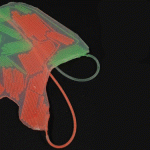
Cotton fabrics may store enough energy to power a mobile phone. Image: Shutterstock
Soon you will be able to charge your mobile phone with a humble T-shirt.
For the past few years, researchers have been trying to develop wearable electronics, but the task has proven to be quite a challenge
In 2010, researchers from the American Chemical Society reported applying a type of ink made from single-walled carbon nanotubes (graphene) to cotton and polyester fabrics. The results were promising, as the textiles had an excellent capability to store energy, but the process is expensive and the ink is not considered an environmentally friendly product.
Inspired by previous experiments, Xiaodong Li, professor of mechanical engineering at the University of South Carolina, has turned a cotton T-shirt into a source of electrical power.
Li and postdoctoral associate Lihong Bao bought a cotton T-shirt from a local discount store and dipped it into a 1M NaF solution. The researchers dried it in a preheated oven at 120 degrees Celsius for three hours. The dried fabric was then annealed in a horizontal tube furnace at 800-1,000 degrees Celsius for 60 minutes with a continuous flow of argon gas. After cooling it, they washed it with distilled water. The result: activated carbon fabric, which, according to the researchers, “proved to be a repository for electricity.”
To enhance the electrode performance of the fabric, the researchers coated the carbon textile with nanoflowers of manganese oxide. The process, said the researchers, generated a stable high-performing supercapacitator. The result activated carbon textile that can last 1,000 charge-discharge cycles.
In their report, which was published in Advanced metamaterials, the authors wrote: “The textile-based asymmetric supercapacitors exhibited superior electrochemical characteristics. Such design opens up a new way for the functionalisation of cotton textiles as supercapacitor building blocks and provides a low-cost and green solution for textile-based energy-storage devices.”
This technology will help us achieve a further integration of mobile phones and gadgets into our lives. “We wear fabric every day,” said Li. “One day our cotton T-shirts could have more functions; for example, a flexible energy storage device that could charge your cell phone or your iPad.”
Source: University of South Carolina






